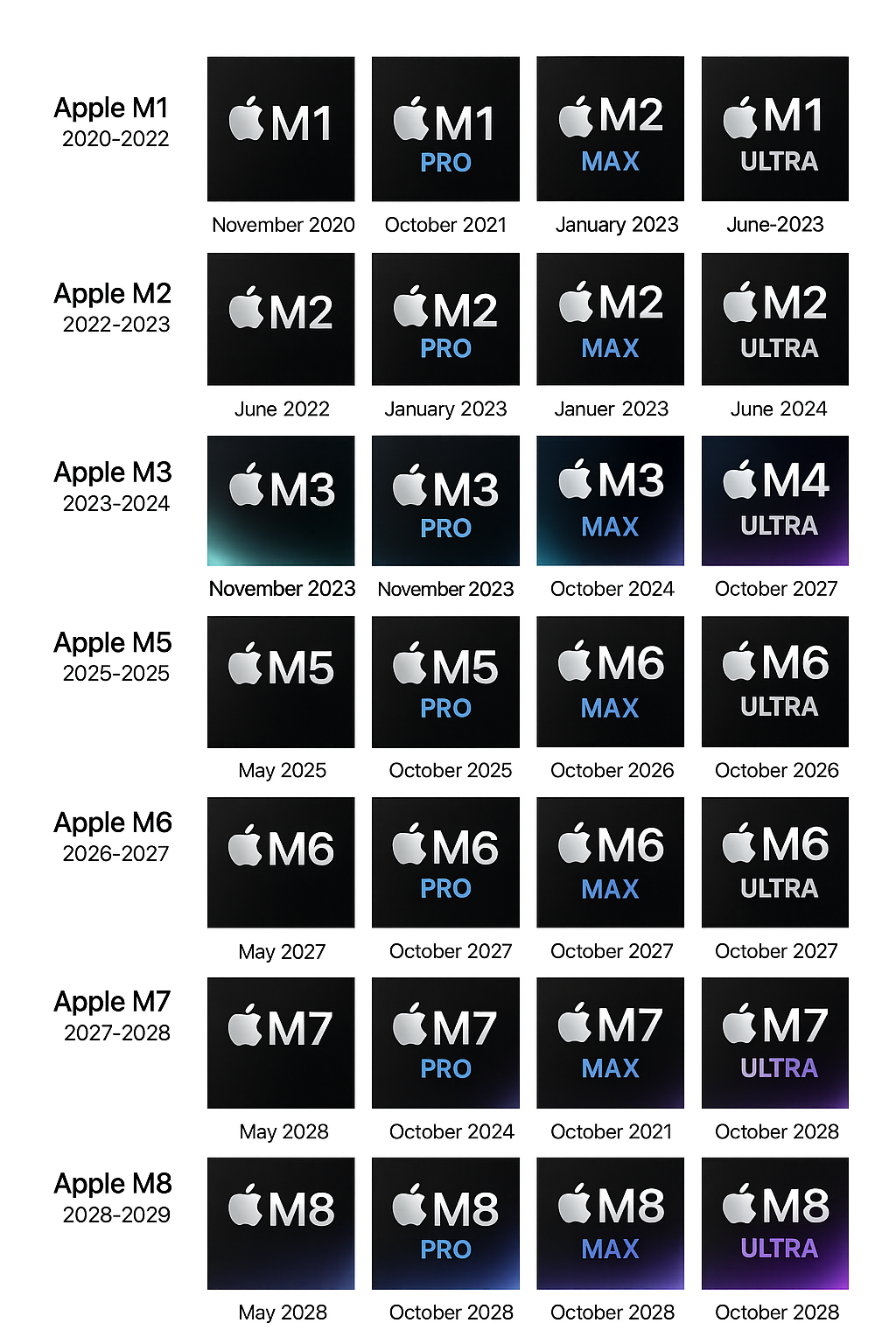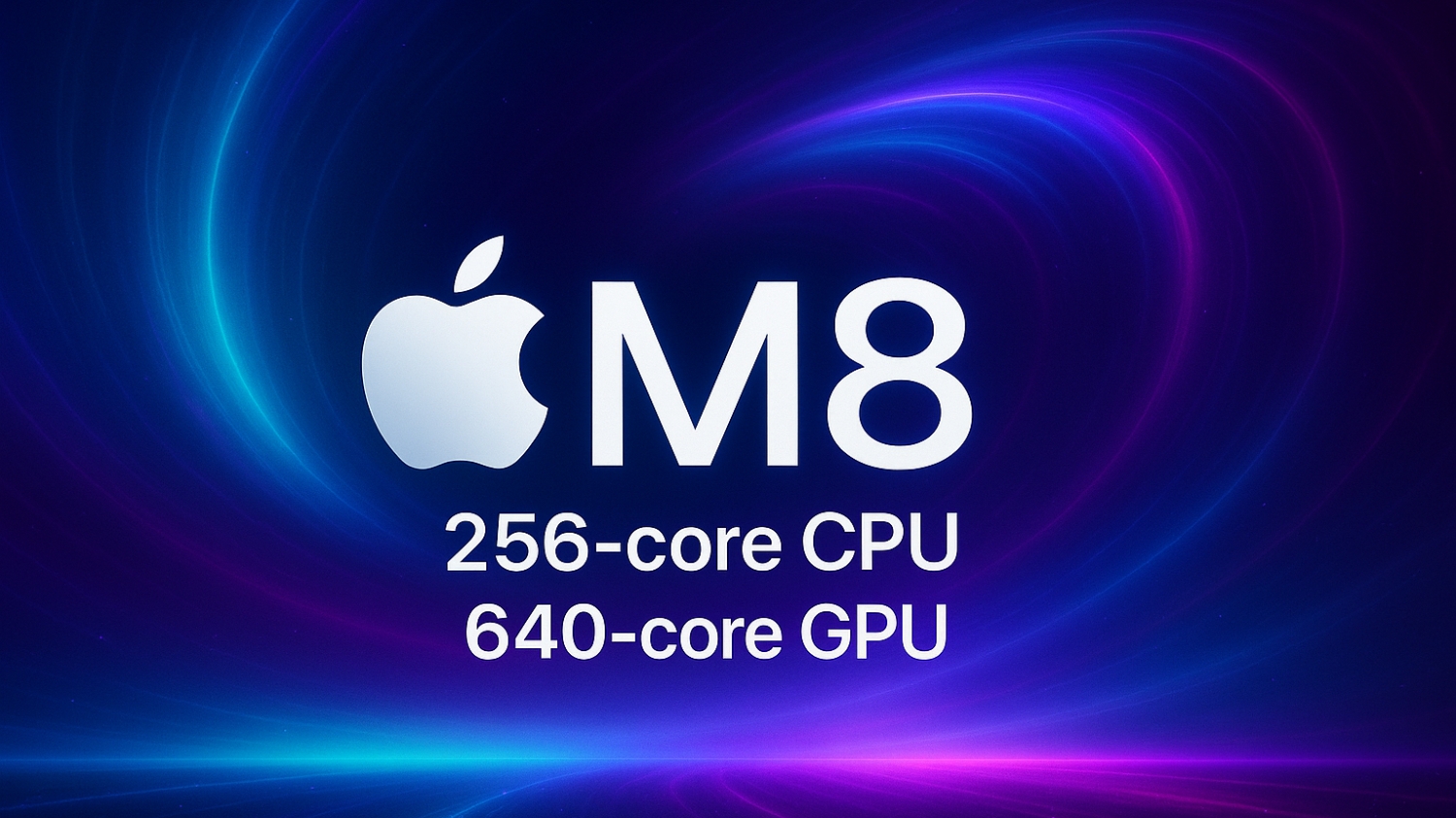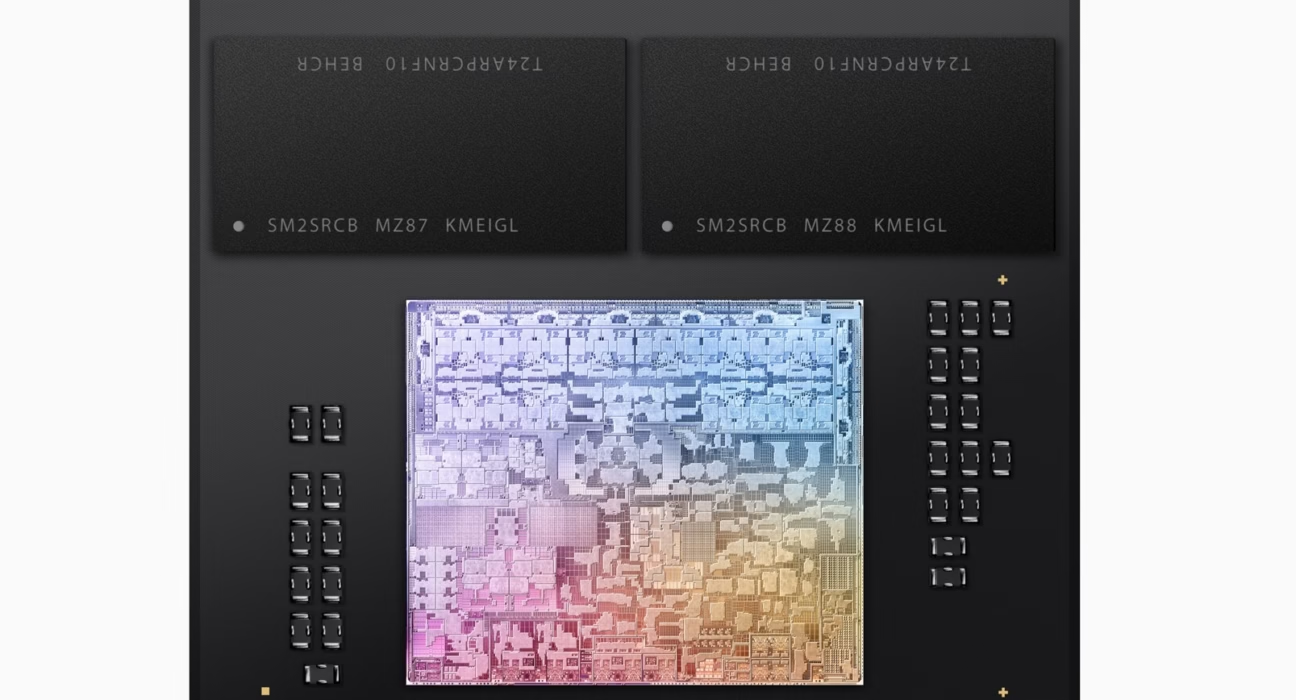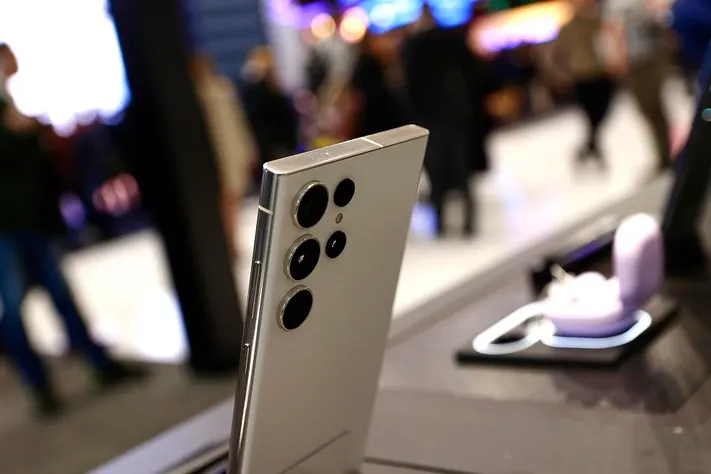Apple M6 M7 Chips: The Future of AI Features on Your Mac
Estimated reading time: 10 minutes
Key Takeaways
- The upcoming Apple M6 chip and Apple M7 chip are poised to significantly enhance AI capabilities for Mac users.
- The M6, codenamed “Komodo,” is expected to be the first Apple Silicon built on TSMC’s 2nm process, offering substantial performance and efficiency gains.
- Potential core counts for high-end M6 configurations could reach up to 256 CPU cores and 640 GPU cores, vastly exceeding current M3 Ultra specifications.
- The primary focus for the M6 is enhanced on-device AI performance, with significantly upgraded Neural Processing Units (NPUs).
- The M7, codenamed “Borneo,” represents a further leap, with advanced AI capabilities potentially enabling new product categories.
- These chips will power a new wave of Mac AI features, including more intelligent Siri, advanced media processing, and optimized system performance.
- Apple Intelligence, Apple’s on-device AI strategy, will be deeply integrated with these new chips, prioritizing privacy and responsiveness.
- M6-powered Macs are anticipated in late 2026, with M7 following in 2027 or later.
Table of contents
- Apple M6 M7 Chips: The Future of AI Features on Your Mac
- Key Takeaways
- The Trajectory of Apple Silicon: A Foundation for Innovation
- Unpacking the Apple M6 Chip: The Komodo Advancements
- The Next Horizon: Introducing the Apple M7 Chip
- Revolutionizing Mac AI Features with Next-Generation Chips
- The Central Role of Apple Intelligence
- Impact on Users and the Mac Ecosystem
- Anticipating the Arrival: Timelines for M6 and M7
- Looking Ahead: The Future of Mac AI is Here
- Frequently Asked Questions
The Trajectory of Apple Silicon: A Foundation for Innovation
The evolution of Apple’s custom silicon has been nothing short of remarkable. Since the introduction of the first Apple Silicon chip, the M1, the company has consistently pushed the boundaries of performance, energy efficiency, and integrated capabilities. Each subsequent generation—M2, M3, and M4—has brought iterative improvements, subtly but surely enhancing machine learning capabilities and overall user experience. This relentless progress has laid a robust foundation, preparing the ground for the ambitious advancements we expect with the upcoming Apple M6 chip and Apple M7 chip. The journey from the M1 to the M4 demonstrates Apple’s strategic commitment to silicon innovation, making it clear that the future of the Mac is intrinsically tied to the power and intelligence packed into these custom processors. This continuous development is not merely about faster chips; it’s about creating a platform that can support increasingly sophisticated computational tasks, paving the way for a new era of *intelligent computing*. This relentless pursuit of silicon excellence has set the stage for even more ambitious leaps forward, particularly in the realm of artificial intelligence.

Unpacking the Apple M6 Chip: The Komodo Advancements
The whispers in the tech world point to the Apple M6 chip, codenamed “Komodo,” as a significant turning point. It’s anticipated to be the *first Apple Silicon to leverage TSMC’s cutting-edge 2nm process technology*. This is a monumental leap, enabling a dramatically higher density of transistors within the same physical space. The direct benefits of this will be *faster processing speeds and significantly improved power efficiency*. Imagine your Mac performing complex tasks with even greater speed while drawing less power—that’s the promise of 2nm.

Furthermore, the core counts are projected to see a substantial increase. While current high-end chips like the M3 Ultra offer impressive performance, the M6 is rumored to boast configurations with up to a staggering *256 CPU cores and 640 GPU cores*. To put that into perspective, this is a massive jump from current specifications, suggesting capabilities far beyond what most users currently experience.

However, the most critical aspect of the Apple M6 chip will be its *enhanced specialized AI performance*. Apple is heavily investing in its Neural Processing Units (NPUs), and the M6 will feature significantly upgraded NPUs engineered with a singular focus: to handle complex, on-device AI tasks with exceptional efficiency and, crucially, with enhanced privacy. This means more sophisticated AI functions can run directly on your Mac, rather than relying on cloud servers, offering a more secure and responsive experience. As noted in industry reports, the focus is squarely on unlocking a new level of *Mac AI features* through hardware designed from the ground up for artificial intelligence.
The Next Horizon: Introducing the Apple M7 Chip
Running concurrently with the development of the M6 is the Apple M7 chip, internally codenamed “Borneo.” While the M6 represents a significant advancement, the M7 is being positioned as a *further generational leap*, particularly in its AI capabilities. This chip is expected to be the bedrock for truly next-generation artificial intelligence on Apple devices, potentially enabling entirely new product categories and functionalities. Think beyond current-day applications; the M7’s architecture is likely being designed with future innovations in mind, such as advanced AR/VR devices or entirely new forms of smart hardware that are deeply integrated with AI.

The timeline suggests that the M7 will follow the M6. While the M6 is anticipated to debut in Macs around late 2026, the Apple M7 chip is projected for release in 2027 or later. This staggered approach allows Apple to refine its technologies and introduce distinct levels of AI prowess across its product lineup. The M7’s focus on even more advanced AI suggests a future where Macs aren’t just tools for productivity and creativity, but intelligent companions that can anticipate needs and perform complex tasks autonomously.
Revolutionizing Mac AI Features with Next-Generation Chips
The true excitement surrounding the Apple M6 chip and Apple M7 chip lies in the tangible Mac AI features they will unlock. Users can anticipate a dramatic overhaul of existing functionalities and the introduction of entirely new intelligent experiences.
* Enhanced Siri Capabilities: Expect Siri to become far more conversational and context-aware. Real-time, *on-device natural language understanding* will allow for more intuitive voice commands and complex queries to be processed instantly, without needing to send data to the cloud. This means faster responses and a more natural interaction model.
* Advanced Image and Video Processing: The new NPUs will power sophisticated AI algorithms for media. This could include *automated video editing* that suggests the best cuts, intelligent media categorization that organizes your photo and video library with unprecedented accuracy, and real-time AI-driven effects that can be applied seamlessly during recording or playback.

* Accelerated Pro-Level Machine Learning: Creative professionals will see a significant boost. Tasks such as faster graphics rendering, more intuitive music production workflows with AI-assisted composition and mixing, and advanced generative design powered by AI will become commonplace. This hardware acceleration will drastically reduce wait times and enable more complex creative endeavors.
* System-Level Optimizations: Beyond user-facing applications, the chips will drive intelligence at the core of macOS. This includes *intelligent resource management* that dynamically allocates power and processing for peak performance, proactive security monitoring that identifies and neutralizes threats in real-time, and adaptive battery optimization that learns user habits to extend device longevity.

* Enhanced On-Device Natural Language Processing (NLP): The upgraded NPUs will supercharge NLP tasks. Imagine near-instantaneous, context-aware text generation for emails or documents, seamless on-device translation of text and spoken language, and accurate document summarization—all processed locally, ensuring maximum privacy and speed. These advancements mean your Mac will understand and process language with a sophistication never before seen on a personal computer.
The Central Role of Apple Intelligence
At the heart of these upcoming capabilities is Apple Intelligence. This isn’t just a feature; it’s Apple’s comprehensive strategy for weaving advanced AI directly into the fabric of its user experiences and workflows. The Apple M6 chip and Apple M7 chip are the *hardware powerhouses* that will bring Apple Intelligence to life on the Mac.

A cornerstone of Apple Intelligence is its unwavering commitment to on-device processing. This approach is a critical differentiator. By processing AI tasks locally, Apple ensures that sensitive user data remains private and secure. Furthermore, on-device processing leads to *superior system responsiveness* and greater reliability, as it doesn’t depend on constant network connectivity or server availability. This stands in stark contrast to many AI solutions that rely heavily on cloud computing, raising privacy concerns and introducing potential latency.
The synergy between Apple’s custom silicon and its AI software is what will define the future of the Mac ecosystem. This tight integration between hardware, specifically the Apple M6 chip and Apple M7 chip, and software like macOS and Apple Intelligence, will serve as a key differentiator, offering a seamless, intelligent, and private computing experience that is uniquely Apple.

Impact on Users and the Mac Ecosystem
The tangible benefits of the Apple M6 chip and Apple M7 chip will ripple across all Mac users, profoundly impacting how we interact with our devices. For creative professionals, the enhanced AI capabilities will translate into *faster workflows, more powerful tools, and the ability to explore more ambitious projects* without being hindered by processing limitations. Students and academics will find new ways to leverage AI for research, writing, and learning, with tools that can summarize complex texts, assist with coding, and even help in data analysis. Professionals across various industries will experience a more personalized and efficient computing environment, with Macs proactively assisting in tasks, managing schedules, and streamlining communications.

The introduction of these next-generation Mac chips will solidify the Mac’s position as a leading platform for both productivity and creativity. The robust hardware acceleration for AI will not only make current tasks faster but also ensure that Macs remain relevant and capable for years to come, able to handle the ever-increasing demands of AI-driven software. This sustained performance, coupled with Apple’s commitment to long-term software support, means a better return on investment for users and a more consistent experience across the entire Mac lineup.
Ultimately, these advancements underscore Apple’s strategic vision to maintain a competitive edge in the rapidly evolving personal computing market. By controlling the entire stack—from silicon design to software integration—Apple can deliver experiences that are both groundbreaking and cohesive. The ability to innovate rapidly in areas like AI, directly within their hardware, positions Apple to lead the charge in defining the future of intelligent personal computing.

Anticipating the Arrival: Timelines for M6 and M7
For those eager to experience the power of these next-generation chips, here are the projected timelines. Macs equipped with the advanced Apple M6 chip are anticipated to launch in late 2026. This release will mark the first wave of devices to benefit from the significant improvements offered by the Komodo architecture and its 2nm process technology.

Following closely behind, Macs powered by the even more advanced Apple M7 chip are expected to arrive in 2027 or later. This staggered release schedule allows Apple to introduce distinct tiers of AI capability and ensure that each generation of silicon brings a meaningful step forward in performance and functionality.
*It is important to note* that these timelines are based on industry analysis and reporting from reputable sources. Apple’s internal development and manufacturing schedules can influence exact release dates, so these are estimations, not guarantees. However, they provide a clear indication of when we can expect to see these revolutionary chips integrated into the Mac lineup.
Looking Ahead: The Future of Mac AI is Here
The convergence of the Apple M6 chip and Apple M7 chip with Apple Intelligence signifies a pivotal moment for the Mac. These next-generation Mac chips are not just incremental upgrades; they represent a fundamental shift towards more powerful, private, and intuitive on-device AI capabilities. The focus on enhanced Neural Processing Units, combined with cutting-edge manufacturing processes, ensures that Macs will be at the forefront of artificial intelligence in personal computing.

Apple’s dedication to integrating advanced AI directly into its hardware and software ecosystem promises a future where Macs are more than just tools—they will be intelligent partners, capable of understanding and responding to user needs in sophisticated ways. This approach ensures not only enhanced performance but also a strong emphasis on user privacy, a hallmark of Apple’s philosophy.
What AI-powered feature are you most excited to see on future Macs?
Frequently Asked Questions
Q: What is the main advantage of the 2nm process technology for the M6 chip?
A: The 2nm process technology allows for significantly higher transistor density, leading to faster processing speeds and improved power efficiency, meaning more power in a smaller, more efficient package.
Q: Will Apple Intelligence require an internet connection to function?
A: A key principle of Apple Intelligence is on-device processing for many tasks, prioritizing privacy and speed. While some advanced features might leverage cloud-based AI for complex queries, core functionalities will operate locally.
Q: Are the core count increases for the M6 chip confirmed?
A: The reported core counts (up to 256 CPU and 640 GPU) are based on industry leaks and analysis. Apple has not officially confirmed these figures, but they indicate a significant leap in processing power.
Q: How will the M6 and M7 chips impact the longevity of Macs?
A: By providing substantial hardware acceleration for AI and other demanding tasks, these chips will ensure that Macs remain performant and capable for a longer duration, capable of handling future software advancements.
Q: When can I expect to buy a Mac with an M6 or M7 chip?
A: Macs with the M6 chip are anticipated in late 2026, with M7-powered Macs expected in 2027 or later.




